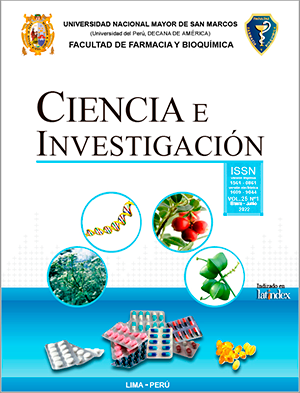Bactericidal and fungicidal effect of cimenol ring-citric acid formulation on experimentally feed-maize contaminated
DOI:
https://doi.org/10.15381/ci.v25i1.23473Keywords:
Cimenol ring-citric acid, bactericidal, antifungals, feed maizeAbstract
The indiscriminate use of antimicrobials (bactericidal, antifungals, or antivirals), used prophylactically in food or therapeutically in the poultry industry, has caused growing concern about the antimicrobial resistance of many microorganisms, endangering the effectiveness of prevention and the treatment of certain infections. Therefore, several production industries, including the poultry industry, are choosing to replace these commercial antimicrobials with natural antimicrobial agents that come from medicinal plants, evaluating the effects of their extracts or these secondary metabolites. Therefore, the study aimed to evaluate the antimicrobial activity (bactericidal and antifungal) from a natural formulation of cimenol-citric acid ring (ACAC) against experimentally contaminated corn with Pseudomonas sp, Clostridium sp, Escherichia coli, Salmonella sp, Fusarium sp, Rhizopus sp and Aspergillus sp at 103 and 106 CFU/g concentrations. ACAC was compared against two commercial formulations of organic acids (A: formic acid/propionic acid, and B: 90% propionic acid), using two treatment time for 24 and 7 days. The results show that ACAC had an antibacterial effect greater than 95% (experiments: 103 and 106 CFU/g), with a greater effect of the product at 7 days of treatment rather than to 24 h (experiment: 106 CFU/g). It has also been observed that ACAC had an antifungal effect greater than 84% (experiments: 103 and 106 CFU/g). The antimicrobial effect of ACAC was shown to be better against commercial organic acids A and B. Therefore, the present study has shown that ACAC (treatment for 24 hours and 7 days) has a good antibacterial and antifungal effect against pathogens: Pseudomonas sp., Escherichia coli, Clostridium perfringens, Salmonella sp., Rhizopus sp., Fusarium sp. and Aspergillus sp., which are frequently present in corn or feed intended for feeding broilers chickens.
Downloads
Published
Issue
Section
License
Copyright (c) 2022 Hugo Patiño-López, Zoyla-Mirella Clavo, Norma Ramos-Cevallos, Miguel Quispe, José-Luis Rodríguez, Mariella Ramos-Gonzalez

This work is licensed under a Creative Commons Attribution 4.0 International License.
LOS AUTORES RETIENEN SUS DERECHOS:
- Los autores retienen sus derechos de marca y patente, y tambien sobre cualquier proceso o procedimiento descrito en el artículo.
- Los autores retienen el derecho de compartir, copiar, distribuir, ejecutar y comunicar públicamente el articulo publicado en la Revista Ciencia e Investigación (por ejemplo, colocarlo en un repositorio institucional o publicarlo en un libro), con un reconocimiento de su publicación inicial en la Revista Ciencia e Investigación.
- Los autores retienen el derecho a hacer una posterior publicación de su trabajo, de utilizar el artículo o cualquier parte de aquel (por ejemplo: una compilación de sus trabajos, notas para conferencias, tesis, o para un libro), siempre que indiquen la fuente de publicación (autores del trabajo, revista, volumen, numero y fecha).






